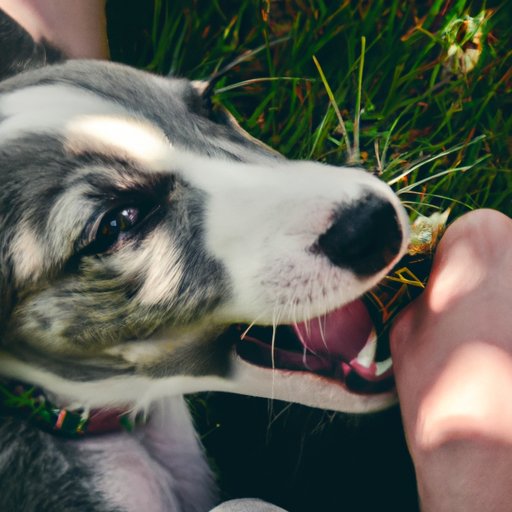
I. Introduction
Training your new puppy is an important and exciting process for any new dog owner. One of the common challenges new owners face is puppy biting, which can be painful and frustrating. While it is important to remember that biting is a natural behavior for puppies, it’s important to teach them not to bite. In this article, we will explore common reasons puppies bite and effective techniques for stopping this behavior in its tracks.
II. Why Do Puppies Bite
Understanding why your puppy bites is the first step in stopping the behavior. Here are some common reasons puppies bite:
A. Teething and exploration
Puppies will often bite as a way to explore their environment and alleviate the pain of teething. Biting helps to soothe the discomfort they feel in their mouths – similar to how teething infants put objects in their mouths to alleviate pain.
B. Attention-seeking behavior
Puppies may bite to get attention from their owners. This can happen if they feel ignored or if they are seeking physical contact.
C. Fear and aggression
Puppies may bite if they feel threatened or fearful. This can happen in new or stressful situations. In some cases, puppies may bite as a way to protect themselves.
D. Playful behavior
Puppies may also bite as a form of play. They may nip or bite during playtime and this may escalate to aggressive behavior if not addressed.
III. How to Stop Your Puppy’s Biting
Now that you understand the reasons behind your puppy’s biting behavior, here are some effective techniques to stop it:
A. Teaching bite inhibition
Bite inhibition refers to the ability of your puppy to control their bite strength. To teach your puppy bite inhibition, try the following:
1. Redirecting attention to toys
When your puppy tries to bite you, redirect their attention to a toy. This will teach them that biting toys is more appropriate than biting people.
2. Yelping or ignoring
If your puppy bites you during play, yelp loudly. This will signal to your puppy that their bite was too hard. You can then ignore your puppy for a few seconds before resuming playtime. Consistent yelping and ignoring will help teach your puppy to control their bite strength.
3. Positive reinforcement
Positive reinforcement is another way to teach your puppy bite inhibition. When your puppy bites a toy instead of your hand, reward them with a treat or praise. This will help reinforce appropriate behavior.
B. Consistency is key
Consistency is important when you’re trying to stop your puppy’s biting behavior. Here are some ways to create a consistent training environment:
1. Creating a routine
Create a consistent routine that includes eating, sleeping, and playtime. Your puppy will be more likely to respond positively to training if they know what to expect. Consistent training will help reinforce good behavior.
2. Training family and visitors
Make sure everyone in your household is on board with training your puppy. Teach them how to redirect your puppy’s biting behavior and encourage them to respond consistently. Visitors should also be instructed on how to interact with your puppy.
C. Exercise and socialization
Exercise and socialization are important aspects of raising a well-behaved puppy. Here’s how to use them to decrease biting behavior:
1. Exercise to decrease play biting
Puppies that are tired from exercise will be less likely to engage in rough play and biting behaviors. Make sure to provide plenty of exercise opportunities for your puppy to decrease biting.
2. Socializing with other dogs
Socializing your puppy with other dogs will help them learn appropriate play behaviors. Make sure to supervise their interactions and intervene if necessary.
3. Encouraging good obedience
Teaching your puppy basic obedience skills will help them learn impulse control. When your puppy understands basic obedience commands like “sit,” “stay,” “come,” and “heel,” they will be better equipped to control biting behavior.
IV. Mistakes to Avoid When Stopping Puppy Biting
There are several mistakes that can make it harder to stop your puppy’s biting behavior. Here are some things to avoid:
A. Using physical punishment
Using physical punishment to stop biting can lead to more aggressive behavior. Puppies don’t understand physical punishment and it can create a fear of their owner. Instead, use positive reinforcement to encourage good behavior.
B. Encouraging roughhousing
While it can be fun to play rough with your puppy, it can also encourage biting behavior. Stick to gentle play and avoid roughhousing to decrease biting behavior.
C. Not creating boundaries
Puppies need clear boundaries to understand what is and is not acceptable behavior. Make sure to set clear boundaries for your puppy and enforce them consistently.
V. Conclusion
Stopping your puppy’s biting behavior is an important part of training and raising a well-behaved dog. By understanding why puppies bite and using effective techniques, you can stop this behavior in its tracks. Remember to be patient and consistent, and to avoid common mistakes like physical punishment and roughhousing. With the right tools and techniques, you can teach your puppy to be a well-behaved, lovable dog.





